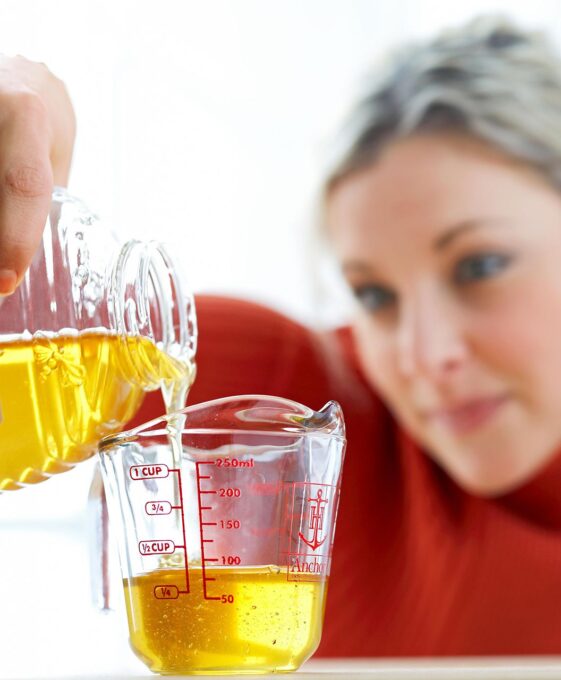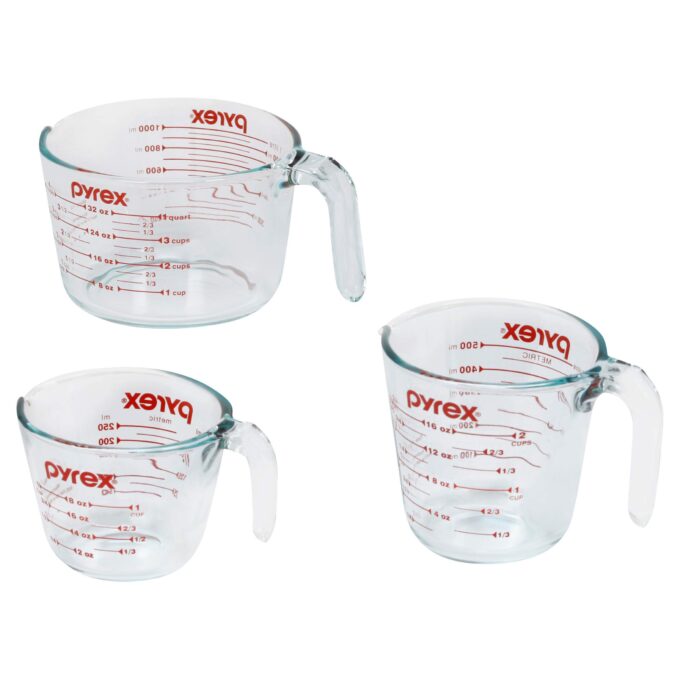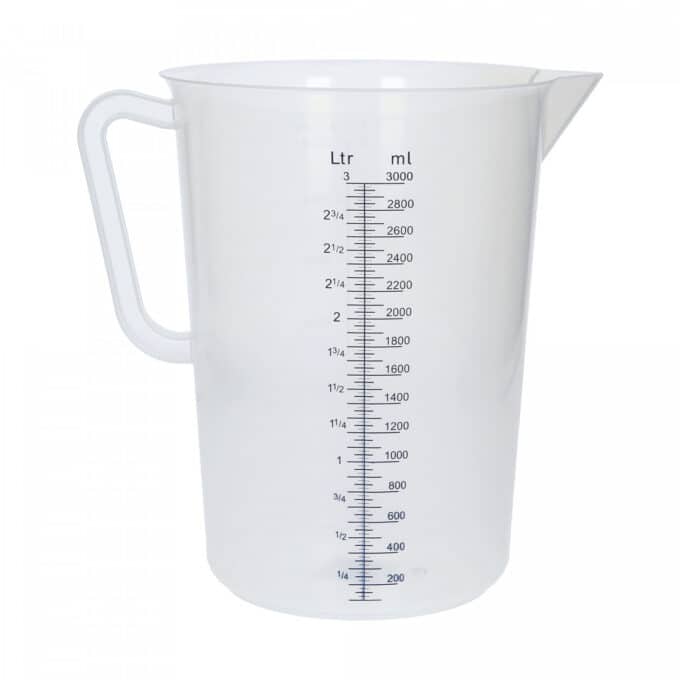How many millilitres are in a cup? This is a common question in cooking and baking, especially when following recipes requiring precise measurements.
When it comes to cooking and baking, accurate measurements are essential for achieving the desired results. One of the most common measurements used in recipes is the cup, which is often abbreviated as “c.”
However, cups can come in different sizes depending on where you are in the world. If you’re not sure how many millilitres are in a cup, this article will provide you with the information you need to make accurate measurements in your kitchen.

CHECK THIS:
What is a Cup
1 cup is 8 ounces. There are 16 cups in a gallon, 8 in a half-gallon, 4 in a quart, and 2 in a pint. A cup is a unit of volume measurement (whereas ounces measure weight).
Cup Measurement
When measuring ingredients for cooking and baking, cups are a common unit of measurement. However, it’s important to understand what a cup measurement actually means. A cup is a unit of volume, representing the amount of space a particular ingredient occupies.
In the United States, a standard cup measurement is equal to 8 fluid ounces. This means that a cup of liquid will weigh different amounts depending on what the liquid is. For example, a cup of water weigh 8 ounces, but a cup of honey weigh more because it is denser than water.
It’s also important to note that a cup measurement is not always the most precise way to measure ingredients. For some recipes, measuring ingredients by weight or volume may be more accurate using millilitres or teaspoons.
In general, understanding how to measure ingredients accurately is an important skill for any cook or baker, and knowing how many millilitres are in a cup is a key part of that knowledge.
RELATED READ: Vegetable Soup Recipes: How To Cook the Nigerian Efo Riro
Milliliter as a Unit of Volume
Milliliter (ml) is a metric unit of volume measurement that is commonly used in scientific and medical applications, as well as in cooking and baking. It is equivalent to one-thousandth of a litre, which is the base unit of volume in the metric system.
The millilitre is often used to measure liquids such as water, milk, and oil. It can also be used to measure the volume of small objects or quantities of powders or granules. A millilitre is a convenient unit of measurement because it is small enough to measure precise amounts but large enough to be practical for everyday use.
Converting Milliliters to cup
To convert millilitres to cups, you need to know the conversion factor, which is the ratio of millilitres to cups. The conversion factor depends on whether you are converting liquid ingredients or dry ingredients.
For liquid ingredients, 1 cup is equal to 240 millilitres. This means that 240 millilitres of liquid is equivalent to 1 cup.
To convert millilitres to cups for liquid ingredients, you need to divide the number of millilitres by 240. For example, if you have 500 millilitres of water that you want to convert to cups, you would divide 500 by 240 to get the answer in cups. This gives you approximately 2.08 cups.
For dry ingredients, 1 cup is equal to 236.6 millilitres. This means that 236.6 millilitres of dry ingredients is equivalent to 1 cup.
To convert millilitres to cups for dry ingredients, you need to divide the number of millilitres by 236.6. For example, if you have 500 millilitres of flour that you want to convert to cups, you would divide 500 by 236.6 to get the answer in cups. This gives you approximately 2.11 cups.
It’s important to note that these conversion factors are approximate and may vary slightly depending on factors such as the density and temperature of the ingredient. However, they are generally accurate enough for most cooking and baking purposes.
Converting Chart
Metric | Fluid Ounce | Cups |
| 50ml | 1.69 | 0.211 |
| 100ml | 3.38 | 0.42 |
| 200ml | 6.76 | 0.85 |
| 33ml | 11.3 | 1.41 |
| 500ml | 16.9 | 2.11 |
| 1liter | 33.8 | 4.2 |
| 1.5liters | 50.7 | 6.3 |
| 2liters | 67.6 | 8.5 |
| 5liters | 169 | 21.1 |
| 10liters | 338 | 42.3 |

Converting Cups to Milliliters
Converting cups to millilitres is a common task in cooking and baking, as recipes often use measurements in both units. To convert cups to millilitres, you need to know the conversion factor: the ratio of cups to millilitres. The conversion factor depends on whether you are converting liquid ingredients or dry ingredients.
For liquid ingredients, 1 cup is equal to 240 millilitres. This means that 1 cup of liquid is equivalent to 240 millilitres of liquid.
To convert cups to millilitres for liquid ingredients, you need to multiply the number of cups by 240. For example, if you have 2 cups of water that you want to convert to millilitres, you would multiply 2 by 240 to get the answer in millilitres. This gives you 480 millilitres.
For dry ingredients, 1 cup is equal to 236.6 millilitres. This means that 1 cup of dry ingredients is equivalent to 236.6 millilitres of dry ingredients.
To convert cups to millilitres for dry ingredients, you need to multiply the number of cups by 236.6. For example, if you have 2 cups of flour that you want to convert to millilitres, you would multiply 2 by 236.6 to get the answer in millilitres. This gives you 473.2 millilitres.
It’s important to note that these conversion factors are approximate and may vary slightly depending on factors such as the density and temperature of the ingredient. However, they are generally accurate enough for most cooking and baking purposes.
Converting Cups to Milliliters Using Chart
Imperial | Millilitres | Litres |
| ¼ cup | 59 | 0.06 |
| ½ cup | 118 | 0.12 |
| 1 cup | 237 | 0.24 |
| 2 cups(1 pint) | 473 | 0.47 |
| 4 cups(1 quart) | 946 | 0.95 |
| 8 cups(1/2 gallon) | 1892 | 1.89 |
| 16 cups (1 gallon) | 3785 | 3.78 |
Milliliters Measurement
Millilitres (ml) are typically used to measure liquids, such as water, milk, juice, vinegar, and oil. However, ml can also be used to measure the volume of certain solids, such as small grains, seeds, or powders.
In cooking and baking, millilitres are often used in recipes, particularly in those that require precise measurements. For example, ml may be used to measure the amount of liquid needed to make a cake batter, the amount of sauce needed for a stir-fry, or the amount of oil needed for a salad dressing.
Millilitres are also used in various fields, such as medicine, chemistry, and engineering to accurately measure small amounts of liquids.

Cup Sizes in Different Countries
Different countries may use different cup sizes, which can create confusion when following recipes or converting between units. Here are some examples of cup sizes used in different countries:
United States: The standard cup measurement in the US is 240 ml.
Australia: The standard cup measurement in Australia is 250 ml.
Canada: The standard cup measurement in Canada is 227 ml.
United Kingdom: The standard cup measurement in the UK is 284 ml.
Japan: The standard cup measurement in Japan is 200 ml.
It’s important to keep in mind the regional differences in cup sizes when using recipes from different sources or converting between units.
SEE THIS: How to make Buttermilk
Equipment for Measuring Milliliters
Here are some of the equipment to measure millilitres:
Measuring Cups
Measuring cups are commonly used for measuring liquids like water, milk, and other liquids. They are usually made of plastic or glass and come in different sizes, such as 1 cup, ½ cup, ⅓ cup, and ¼ cup.
Measuring Spoons
Measuring spoons are used to measure small amounts of liquids or powders, such as vanilla extract, baking powder, or salt. They come in different sizes, such as 1 tablespoon, 1 teaspoon, ½ teaspoon, and ¼ teaspoon.
Graduated Cylinder
Graduated cylinders are used to measure larger quantities of liquids. They are typically made of glass or plastic and have markings on the side to indicate the volume of liquid they contain.
Syringes
Syringes are often used in medical settings to measure and administer medication, but they can also be used to measure liquids in cooking and baking. They typically have a capacity of up to 10 ml.
Digital Scales
Digital scales can be used to measure both liquid and dry ingredients. They usually have a tare function, which allows you to zero out the weight of the container before measuring the ingredients. Many digital scales also have an ml measurement function.
SEE ALSO:
Importance of Accurate Measurements in Cooking and Baking
Consistency
Accurate measurements ensure consistency in the final product, which is especially important for recipes that need to be replicated.
Taste and Texture
Proper ratios of ingredients ensure that the dish or baked goods have the desired taste and texture.
Chemical Reactions
Baking is a science, and accurate measurements are necessary for the right chemical reactions to occur. For example, if a recipe calls for too much baking powder or soda, the finished product may have a bitter taste or be too dense.
SEE: How to Make Meat Pie
Nutritional Information
Accurate measurements of ingredients are necessary for calculating the nutritional content of a dish or baked goods.
Cost
Accurate measurements can help in managing the cost of ingredients, preventing wastage and unnecessary expense.
Conclusion
In conclusion, understanding the relationship between millilitres and cups is an important aspect of cooking and baking. While a cup is a commonly used unit of volume in the United States, millilitres are used in many other parts of the world.
One cup is equivalent to 240 millilitres of liquid, and it’s important to use the appropriate measuring device for the ingredient being measured to ensure accurate and consistent results.
Additionally, it’s important to keep in mind that the size of a cup can vary by country or region, so it’s always a good idea to double-check the conversion rate before measuring ingredients. With the proper knowledge and tools, anyone can measure ingredients accurately and make delicious dishes in the kitchen.
FAQS on How Many Ml in a Cup
How does ml compare to cups?
Millilitres (ml) and cups are both units of volume, but they measure different amounts. A cup is a unit of volume commonly used in the United States, while millilitres are used in many other countries around the world.
One cup is equivalent to 240 millilitres (ml) of liquid. This means that if a recipe calls for 2 cups of milk, you can measure out 480 ml of milk instead. Similarly, if a recipe calls for 500 ml of water, you can measure out approximately 2 cups of water.
It’s important to note that the size of a cup can vary depending on the country or region, so it’s always a good idea to double-check the conversion rate before measuring ingredients.
How do I convert 200 ml to cups?
200 liters = 845.351Cups. For an appropriate result, multiply the volume value by 4.227. To convert 200 ml to cups, you need to divide the number of millilitres by the equivalent number of millilitres in one cup, which is 240 ml.
So, 200ml ÷ 240ml/cup = 0.83 cups (rounded to two decimal places). Therefore, 200 millilitres is approximately equal to 0.83 cups.
